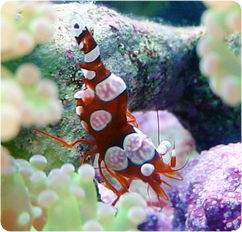|
Mark Martin on Hyposalinity & Inverts
Mark Martin is the Director of Marine Ornamental Research at Blue Zoo Aquatics  This week we are looking at symbiotic animals with an emphasis on symbiotic invertebrates, and so I thought I might take this opportunity to address a question I received recently from an aquarist who was losing all of her invertebrates. This poor woman couldn’t figure out why her shrimp, starfishes and snails were dying prematurely when her fishes appeared so healthy. After asking several questions, I finally figured out what was wrong, and my answer to her is the subject of this week’s “Ask Mark” column. This week we are looking at symbiotic animals with an emphasis on symbiotic invertebrates, and so I thought I might take this opportunity to address a question I received recently from an aquarist who was losing all of her invertebrates. This poor woman couldn’t figure out why her shrimp, starfishes and snails were dying prematurely when her fishes appeared so healthy. After asking several questions, I finally figured out what was wrong, and my answer to her is the subject of this week’s “Ask Mark” column.
Many invertebrates cannot tolerate hyposaline conditions, and this woman, under the misguided advice of an employee at her local fish store, had dropped the salinity in her aquarium to 1.010 ppm. Why would anyone have suggested she lower the salinity of her aquarium water to well below that which is normal in the ocean? There are actually many reasons that aquarist intentionally lower their salinity to around the 1.010 ppm range, and, in a fish-only system, many aquarist believe it is preferred to maintain a slightly hyposaline environment.
The most common reason to lower the salinity in a tank, however, is as a means of treating Cryptocaryon irritans (frequently—albeit incorrectly—referred to as “marine ich”). There are many other reasons as well, as Terry D. Bartelme points out in his excellent June 2007 article http://www.advancedaquarist.com/2007/6/fish in Advanced Aquarist. “Hyposalinity,” Bartelme writes, “can be employed in better acclimating recently transported fish, for quarantine, treating wounds, with antibiotics, getting fish to begin eating, conserving metabolic energy, improving growth and alleviating the effects of stress.”
As it turns out, the well-intentioned local fish store employee thought he was helping her acclimate her new fishes to her established invertebrate tank, without realizing that many invertebrates DO NOT TOLERATE HYPOSALINE CONDITIONS WELL. In short, we concluded that the death of many of her invertebrates was directly related to the fact that she had intentionally lowered her salinity either too quickly or too low.
The take-home point is do not use hyposalinity or hyposalinity treatment in tanks with invertebrates, live rock, or live sand—hyposaline conditions, and especially rapid changes in salinity, will have a detrimental effect on many invertebrates and pods in your aquarium. If you want to use hyposalinity to treat fish infested with crypto in a reef tank, first remove the fishes to a hospital tank and then manipulate the salinity in the hospital tank to the desired level.
If you have a question you would like answered in my weekly “Ask Mark” column, please e-mail me at mark@bluezooaquatics.com. To see all of the past “Ask Mark” tips, please visit the Blue Zoo Aquatics Resources page.
Published 8 September 2008. © Blue Zoo Aquatics
|